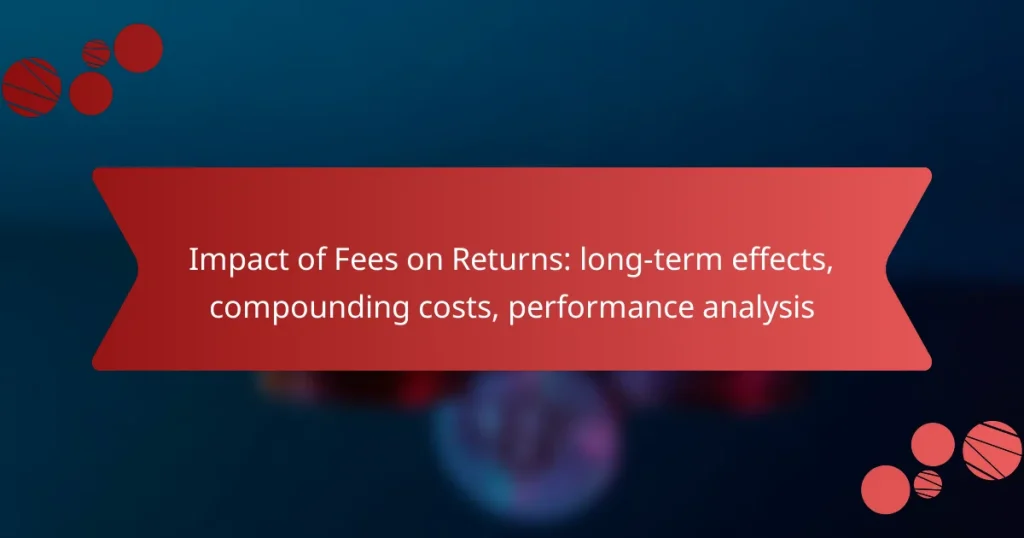Robo-advisors offer a range of pricing structures that can significantly impact your investment experience. Key costs typically include management fees, trading fees, and fund expense ratios, which vary based on the service and investment strategy. Understanding these fees is essential for evaluating the overall value and aligning your choice with your financial goals and budget.
Cost-Effective Robo-Advisors: budget options, value-added services, customer support
Robo-Advisor Cost Transparency: fee disclosures, comparison tools, user experiences
Flat Fee Robo-Advisors: predictable pricing, no percentage fees, budget-friendly
What are the costs associated with robo-advisors?
The costs associated with robo-advisors typically include management fees, account minimums, trading fees, expense ratios, and performance fees. Understanding these costs is crucial for evaluating the overall value and potential returns of using a robo-advisor.
Management fees
Management fees are the primary costs charged by robo-advisors for managing your investment portfolio. These fees usually range from 0.25% to 1% of assets under management (AUM) annually. It’s important to compare these fees across different platforms, as even small differences can significantly impact your investment returns over time.
Some robo-advisors offer tiered pricing, where the fee percentage decreases as your investment amount increases. Be sure to review the fee structure carefully to understand how it may affect your overall investment strategy.
Account minimums
Account minimums refer to the minimum amount of money required to open an account with a robo-advisor. Many platforms have low minimums, often ranging from $0 to a few thousand dollars, making them accessible to a wide range of investors. However, some premium services may require higher initial investments.
When selecting a robo-advisor, consider your own investment capacity and whether the minimum aligns with your financial goals. Some platforms may offer additional features or lower fees for higher account balances, so evaluate these factors as well.
Trading fees
Trading fees are charges incurred when buying or selling assets within your portfolio. Many robo-advisors have eliminated trading fees for standard transactions, but it’s essential to check for any hidden costs associated with specific trades or asset classes. Some may charge fees for rebalancing or trading in certain markets.
Understanding the trading fee structure can help you avoid unexpected costs and optimize your investment strategy. Always review the fee schedule before committing to a platform to ensure it meets your trading needs.
Expense ratios
Expense ratios represent the annual fees charged by mutual funds or ETFs within your robo-advisor’s portfolio. These fees typically range from 0.05% to 1% and cover management, administrative, and operational costs. Lower expense ratios can lead to higher net returns over time.
When evaluating robo-advisors, consider the underlying funds they use and their associated expense ratios. A robo-advisor with lower expense ratios may provide better long-term performance, especially if you plan to invest for several years.
Performance fees
Performance fees are additional charges based on the investment returns generated by your portfolio. Some robo-advisors may charge a percentage of profits above a certain benchmark, typically ranging from 10% to 20%. This fee structure aligns the advisor’s incentives with your investment success.
While performance fees can motivate robo-advisors to maximize returns, they can also eat into your profits. Carefully assess whether a performance fee structure is appropriate for your investment goals and risk tolerance before choosing a robo-advisor.
How do robo-advisor pricing structures compare?
Robo-advisor pricing structures vary significantly, typically involving management fees, fund expense ratios, and sometimes additional charges. Understanding these differences is crucial for selecting a service that aligns with your investment goals and budget.
Wealthfront vs Betterment
Wealthfront generally charges a flat annual management fee of around 0.25% of assets under management, while Betterment’s fee can range from 0.25% to 0.40%, depending on the service tier selected. Both platforms offer low-cost investment options, but Betterment includes features like tax-loss harvesting in its premium plan.
When choosing between the two, consider Wealthfront’s automated tax-loss harvesting and financial planning tools versus Betterment’s personalized advice and goal-based investing. Your decision may hinge on whether you prefer a more hands-off approach or tailored guidance.
Fidelity Go vs M1 Finance
Fidelity Go has no management fees, making it an attractive option for investors looking to minimize costs, while M1 Finance charges no management fees for its basic service but offers premium features at a fee. Fidelity Go is ideal for those who want a simple, hands-off investment experience, while M1 Finance allows for more customization in portfolio management.
Consider your investment style when choosing between these platforms. If you prefer a set-it-and-forget-it approach, Fidelity Go may be best. However, if you want to actively manage your investments, M1 Finance provides greater flexibility.
Acorns vs Ellevest
Acorns charges a monthly fee that ranges from $1 to $5, depending on the plan, while Ellevest’s fees are around 0.25% to 0.50% of assets under management, plus a monthly fee for its subscription services. Acorns is designed for beginners who want to invest spare change, whereas Ellevest focuses on women’s financial goals and offers personalized investment strategies.
When deciding between Acorns and Ellevest, think about your investment experience and financial objectives. Acorns is suitable for those just starting, while Ellevest may be better for individuals seeking tailored investment advice and a focus on gender-specific financial planning.
What factors influence robo-advisor fees?
Robo-advisor fees are influenced by several key factors, including the investment strategy employed, the account size, and the level of service provided. Understanding these elements can help investors make informed decisions about which robo-advisor best fits their financial needs.
Investment strategy
The investment strategy a robo-advisor uses significantly impacts its fees. Strategies can range from passive index tracking to more active management styles. Generally, passive strategies tend to have lower fees, often around 0.25% to 0.50% of assets under management (AUM), while active strategies may charge higher fees, sometimes exceeding 1%.
Investors should consider their risk tolerance and investment goals when evaluating strategies. A more aggressive strategy may yield higher returns but could also incur higher costs, affecting overall profitability.
Account size
Account size plays a crucial role in determining robo-advisor fees. Many firms have tiered pricing structures where fees decrease as account balances increase. For example, an account with $10,000 might incur a fee of 0.50%, while an account with $100,000 could see fees drop to 0.25% or lower.
Investors should assess their expected investment amount and compare fee structures across different robo-advisors. Some platforms may offer flat fees for larger accounts, which can be more cost-effective for high-net-worth individuals.
Service level
The level of service offered by a robo-advisor can also affect its fees. Basic services typically include automated portfolio management and rebalancing, while premium services may offer personalized financial planning or access to human advisors. Basic plans may charge fees around 0.25% to 0.50%, whereas premium services can range from 0.75% to 1.25%.
Investors should evaluate whether they need additional services and how much they are willing to pay for them. It is essential to weigh the benefits of personalized advice against the potential increase in costs.
What are the benefits of using a robo-advisor?
Robo-advisors offer several advantages, including cost-effectiveness, automation, and improved portfolio diversification. They simplify investment management, making it accessible for both novice and experienced investors.
Low-cost investment management
One of the primary benefits of robo-advisors is their low-cost investment management. Typically, they charge fees ranging from 0.25% to 0.75% of assets under management, significantly lower than traditional financial advisors, who may charge 1% or more.
This cost efficiency allows investors to keep more of their returns over time. For example, a $10,000 investment with a 0.25% fee versus a 1% fee can result in substantial savings over several years, potentially amounting to hundreds or thousands of dollars.
Automated portfolio rebalancing
Robo-advisors provide automated portfolio rebalancing, which helps maintain the desired asset allocation. As market conditions change, the value of different investments can shift, leading to an imbalance in your portfolio.
With automated rebalancing, robo-advisors regularly adjust your investments to align with your risk tolerance and investment goals. This process typically occurs quarterly or semi-annually, ensuring your portfolio remains on track without requiring your intervention.
Diversification
Diversification is another key benefit of using a robo-advisor. They typically invest in a mix of asset classes, such as stocks, bonds, and ETFs, which helps spread risk across various investments.
By diversifying your portfolio, you can reduce the impact of poor performance from any single investment. Robo-advisors often use algorithms to determine the optimal mix based on your financial goals and risk tolerance, making it easier for you to achieve a balanced investment strategy.
How to choose the right robo-advisor for your needs?
Choosing the right robo-advisor involves evaluating your financial goals, investment preferences, and the specific services offered. Consider factors such as fees, investment options, and user experience to find a platform that aligns with your requirements.
Assessing fees and services
When assessing fees, look for management fees, trading fees, and any additional costs associated with the robo-advisor. Many platforms charge a management fee that typically ranges from 0.25% to 1% of assets under management (AUM) annually.
Compare the services included in the fee structure. Some robo-advisors offer tax-loss harvesting, financial planning tools, or access to human advisors, which can add significant value depending on your needs.
Evaluating investment options
Evaluate the range of investment options available through each robo-advisor. Most platforms provide diversified portfolios consisting of ETFs, stocks, and bonds, but the specific asset allocation may vary.
Consider whether the robo-advisor allows for customization of your portfolio or if it strictly adheres to pre-set models. Some investors may prefer a hands-on approach, while others might be comfortable with a more automated strategy.
Understanding user experience
User experience is crucial when selecting a robo-advisor. Look for platforms that offer intuitive interfaces, easy navigation, and robust customer support. A seamless experience can significantly enhance your investment journey.
Check for mobile app availability and the quality of educational resources provided. A good robo-advisor should empower you with tools and information to make informed decisions about your investments.
What are the common misconceptions about robo-advisors?
Many people mistakenly believe that robo-advisors are only for tech-savvy investors or that they lack the personal touch of traditional financial advisors. In reality, robo-advisors offer accessible investment management for a wide range of individuals and often include personalized features based on user preferences.
Robo-advisors are only for wealthy investors
A common misconception is that robo-advisors require a high minimum investment, making them exclusive to wealthy individuals. However, many robo-advisors have low or even no minimum investment requirements, allowing anyone to start investing with modest amounts, often as low as a few hundred dollars.
Robo-advisors lack human oversight
Some believe that robo-advisors operate entirely without human intervention. While they primarily use algorithms to manage portfolios, many platforms have human advisors available for consultation, ensuring that clients can receive personalized advice when needed.
Robo-advisors are too risky
Another misconception is that robo-advisors are inherently riskier than traditional investment methods. In reality, robo-advisors typically assess an investor’s risk tolerance and create diversified portfolios that align with their financial goals, often using strategies similar to those employed by human advisors.



